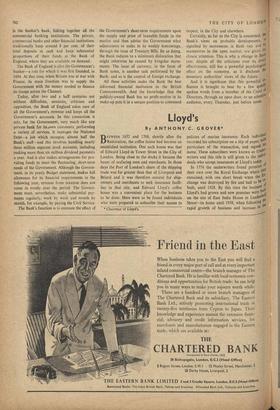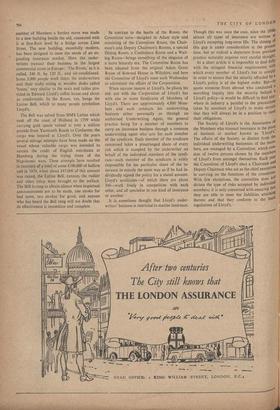Lloyd's
C. GROVER* By ANTHONY D ETWEEN 1652 and 1708, shortly after the LI Restoration, the coffee house had become an established institution. One such house was that of Edward Lloyd in Tower Street in the City of London. Being close to the docks it became the haunt of seafaring men and merchants. In those days the Port of London's share of the shipping trade was far greater than that of Liverpool and Bristol and it was therefore natural for ship- owners and merchants to seek insurance facili- ties in that city, and Edward Lloyd's coffee house was a convenient place for the business to be done. Here were to be found individuals who were prepared to subscribe their names to * Chairman of Lloyd's. policies of marine insurance. Each individual recorded his subscription on a slip of paper, With particulars particulars of the transaction, and signed 1115 name. These subscribers were known as Under: writers and this title is still given to the indiv'' duals who accept insurances at Lloyd's today. f In 1774 the underwriters found premises °„ their own over the Royal Exchange where they remained, with one short break when the °' change was destroyed by fire and had to be Ili built, until 1928. By this time the business °,t Lloyd's had grown and new premises were on the site of East India House in Leadenhail Street—its home until 1958, when following the e rapid growth of business and increase in , number of Members a further move was made to a new building beside the old, connected with it at first-floor level by a bridge across Lime Street. The new building, essentially modern, has been designed to meet the needs of an ex- panding insurance market. Here the under- writers transact their business in the largest commercial room in Europe : 'The Room,' as it is called, 340 ft. by 120 ft., and air-conditioned. Some 3,000 people work there, the underwriters and their staffs sitting at wooden desks called `boxes,' very similar to the seats and tables pro- vided in Edward Lloyd's coffee house and about as comfortable. In the Room, too, hangs the Lutine Bell, which to many people symbolises Lloyd's.
The Bell was salved from HMS Lutine which sank off the coast of Holland in 1799 while carrying gold specie valued at over a million pounds from Yarmouth Roads to Cuxhaven; the cargo was insured at Lloyd's. Over the years several salvage attempts have been made on the vessel whose valuable cargo was intended to sustain the credit of English merchants at Hamburg during the trying times of the Napoleonic wars. These attempts have resulted in recovery of a total of some £100,000 of bullion and in 1859, when about £45,000 of this amount was raised, the Lutine Bell, cannon, the rudder and other relics were brought to the surface. The Bell is rung to obtain silence when important announcements are to be made, one stroke for bad news, two strokes for good, and anyone who has heard the Bell rung will not doubt that its effectiveness is immediate and complete. In contrast to the bustle of the Room, the Committee suite—designed in Adam style and consisting of the Committee Room, the Chair- man's and Deputy Chairman's Rooms, a special Dining Room, a Conference Room and a Wait- ing Room—brings something of the elegance of a more leisurely era. The Committee Room has been adapted from the original Adam Great Room of Bowood House in Wiltshire, and here the Committee of Lloyd's meet each Wednesday to administer the affairs of the Corporation.
When anyone insures at Lloyd's, he places his risk not with the Corporation of Lloyd's but with one or more Syndicates of Members of Lloyd's. There are approximately 4,800 Mem- bers and each conducts his underwriting business either personally or through an authorised Underwriting Agent, the general practice being for a number of members to carry on insurance business through a common underwriting agent who acts for each member of the syndicate. Each member of the syndicate concerned takes a prearranged share of every risk which is accepted by the underwriter on behalf of the individual members of the syndi- cate—each member of the syndicate is solely responsible for his particular share of the in- surance in exactly the same way as if he had in- dividually signed the policy for a stated amount. Lloyd's syndicates—of which there are about 300—work freely in competition with each other, and all specialise in one kind of insurance or another.
It is sometimes thought that Lloyd's under- writers' business is restricted to marine insurance. Though this was once the case, since the 1890s almost all types of insurance are written at Lloyd's excepting long-term life. The closing of this gap is under consideration at the present time, but so radical a departure from previous practice naturally requires very careful thought. In a short article it is impossible to deal fully with the stringent financial requirements with which every member of Lloyd's has to comPlY in order to ensure that the security afforded by 3 Lloyd's policy is of the highest order. But—t0 quote someone from abroad who conducted a searching inquiry into the security behind a Lloyd's policy—it would be difficult to find any' where in industry a parallel to the precautions taken by members of Lloyd's to make certain that they will always be in a position to meet their obligations. The Society of Lloyd's is the Association of the Members who transact insurance in the place of business or market known as 'Lloyd s., The affairs of the Society, as distinct from the individual underwriting businesses of the men"' bers, are managed by a Committee, which con' sists of twelve persons chosen by the members of Lloyd's from amongst themselves. Each Year the Committee of Lloyd's elect a Chairman and Deputy Chairman who act as the chief executives in carrying on the functions of the committee' With few exceptions, the committee does nOt, dictate the type of risks accepted by individual members; it is only concerned with ensuring that they are able to meet the liabilities attaching thereto and that they conform to the basic regulations of Lloyd's. Lloyd's underwriters can only accept busi- ness through the medium of Lloyd's Insurance Brokers; and there are about 220 firms who are permitted by the Committee of Lloyd's to operate in this way. Although they are called `Lloyd's Insurance Brokers' they do not have to place all their business at Lloyd's and they do in fact place business with insurance companies too. To be admitted as a Lloyd's broker is a privilege not lightly given.
The premium income earned by Lloyd's under- writers in respect of all classes of business for the year 1957—the last figures published— amounted to over £276,000,000, more than half of which derives from non-marine categories. With values to be insured constantly rising and new forms of insurance appearing, even this large figure will probably, when the next figures are published, have been greatly exceeded.
It is this adaptability and individual enterprise, together with the unchallenged security behind a Lloyd's policy and the underwriters' determina- tion to continue to meet the needs of the insuring public despite damaging losses, which have led to increasing demands for cover from Lloyd's underwriters.
















































 Previous page
Previous page